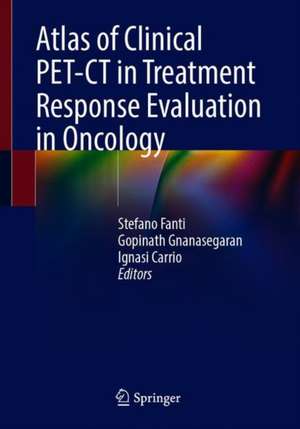Atlas of Clinical PET-CT in Treatment Response Evaluation in Oncology
Editat de Stefano Fanti, Gopinath Gnanasegaran, Ignasi Carrióen Limba Engleză Paperback – 8 iul 2021
Preț: 2127.08 lei
Preț vechi: 2239.03 lei
-5% Nou
Puncte Express: 3191
Preț estimativ în valută:
407.05€ • 422.40$ • 340.23£
407.05€ • 422.40$ • 340.23£
Carte disponibilă
Livrare economică 24 februarie-10 martie
Preluare comenzi: 021 569.72.76
Specificații
ISBN-13: 9783030688578
ISBN-10: 3030688577
Pagini: 488
Ilustrații: XIII, 488 p. 340 illus., 316 illus. in color.
Dimensiuni: 178 x 254 mm
Greutate: 1 kg
Ediția:1st ed. 2021
Editura: Springer International Publishing
Colecția Springer
Locul publicării:Cham, Switzerland
ISBN-10: 3030688577
Pagini: 488
Ilustrații: XIII, 488 p. 340 illus., 316 illus. in color.
Dimensiuni: 178 x 254 mm
Greutate: 1 kg
Ediția:1st ed. 2021
Editura: Springer International Publishing
Colecția Springer
Locul publicării:Cham, Switzerland
Cuprins
PART I General Chapters: Introduction to Treatment response evaluation: Science and Practice.- CT in Treatment response evaluation – Overview.- MRI & Diffusion weighted MRI in Treatment response evaluation- Overview.- PET & PET-CT in Treatment response evaluation-Overview.- Conventional Radiological Techniques and PET-CT in Treatment response evaluation in post-surgical setting.- Conventional Radiological Techniques and PET-CT in Treatment response evaluation in chemotherapy setting.- Conventional Radiological Techniques and PET-CT in Treatment response evaluation in radiation oncology.- Conventional Radiological Techniques and PET-CT in Treatment response evaluation in Immunotherapy settings.- Treatment response evaluation of bone metastases using 18F-NaF.- How to report PET-CT scans in post therapy scenarios: Do’s and don’ts.- PART II Atlas Articles: 18F-FDG & Non FDG PET-CT in Treatment response evaluation in Head and neck cancer.- 18F-FDG & Non FDG PET-CT in Treatment response evaluation in lung cancer.- 18F-FDG & Non FDG PET-CT in Treatment response evaluation in neuro-oncology.- 18F-FDG & Non FDG PET-CT in Treatment response evaluation in hepatobiliary cancer.- 18F-FDG & Non FDG PET-CT in Treatment response evaluation in gastroesophageal cancer.- 18F-FDG & Non FDG PET-CT in Treatment response evaluation in Lymphoma and Non-hodgkins lymphoma.- 18F-FDG & Non FDG PET-CT in Treatment response evaluation in breast cancer.- 18F-FDG, 18F-Choline & 68Ga-PSMA PET-CT in Treatment response evaluation in prostate cancer.- 18F-FDG & Non FDG PET-CT in Treatment response evaluation in gynaecological cancers.- 18F-FDG & Non FDG PET-CT in Treatment response evaluation in colorectal cancer.- 18F-FDG & Non FDG PET-CT in Treatment response evaluation in soft tissue sarcomas.- FDG & Non FDG PET-CT in Treatment response evaluation in malignant melanoma.- 18F-FDG & Non FDG PET-CT in Treatment response evaluation in myeloma.- FDG PET-CT & 18F-NaF in Treatment response evaluation in bone metastases and bone tumours.- 18F-FDG & Non FDG PET-CT in Assessment of treatment response in paediatric oncology.- 68Ga-DOTA PET-CT in Treatment response evaluation in NETs.- 18F-DOPA PET-CT in Treatment response evaluation.- 18F-FLT PET-CT in Treatment response evaluation.- Brain PET-CT in Treatment response evaluation.
Notă biografică
STEFANO FANTI
Professor-Department of Experimental, Diagnostic and Specialty Medicine - DIMES
Research interests are mainly focused on the use of PET in oncology, with particular reference to innovative radiopharmaceuticals. Engaged in national and international research projects, he collaborates with numerous institutions, including IAEA, EANM
GOPINATH GNANASEGARAN
Consultant Physician in Nuclear Medicine at Royal Free London NHS Foundation Trust Hospital NHS Foundation Trust. His specialist interests are hybrid imaging and radionuclide therapy. Former Chair of the British Nuclear Medicine Society Education Committee.
IGNASI CARRIO
Professor of Radiology and Nuclear Medicine at Autonomous University of Barcelona, and Director of the Department of Nuclear Medicine at Hospital Sant Pau in Barcelona, Spain. Main research and scientific activity in Nuclear Medicine and Molecular Imaging, in particular in the fields of Cardiovascular Medicine and Oncology. FormerEditor-in-Chief of the European Journal of Nuclear Medicine and Molecular Imaging. Former President of the European Association of Nuclear Medicine.
Professor-Department of Experimental, Diagnostic and Specialty Medicine - DIMES
Research interests are mainly focused on the use of PET in oncology, with particular reference to innovative radiopharmaceuticals. Engaged in national and international research projects, he collaborates with numerous institutions, including IAEA, EANM
GOPINATH GNANASEGARAN
Consultant Physician in Nuclear Medicine at Royal Free London NHS Foundation Trust Hospital NHS Foundation Trust. His specialist interests are hybrid imaging and radionuclide therapy. Former Chair of the British Nuclear Medicine Society Education Committee.
IGNASI CARRIO
Professor of Radiology and Nuclear Medicine at Autonomous University of Barcelona, and Director of the Department of Nuclear Medicine at Hospital Sant Pau in Barcelona, Spain. Main research and scientific activity in Nuclear Medicine and Molecular Imaging, in particular in the fields of Cardiovascular Medicine and Oncology. FormerEditor-in-Chief of the European Journal of Nuclear Medicine and Molecular Imaging. Former President of the European Association of Nuclear Medicine.
Textul de pe ultima copertă
This text atlas is a superb guide to the use of PET-CT for the evaluation of treatment response in oncology patients based on its ability to assess tumor metabolic status. The first part of the book explains the role of PET-CT in response evaluation in different treatment settings. For comparison, overviews of the value and limitations of CT alone, PET alone, and anatomical and functional MRI are included. Guidance is also provided on the reporting of PET-CT scans in post-therapy scenarios. The second part of the book describes and illustrates the use of PET-CT with FDG and other tracers to assess the treatment response of malignancies at different anatomic sites. Featuring a wealth of images, informative case-based discussion, and evidence-based teaching points, these disease-specific chapters clearly demonstrate the key role that PET-CT can play in distinguishing early responders from patients who are non-responders or are resistant to treatment. Prompt and accurate evaluation of treatment response is vital as we enter the era of individualized medicine, and this atlas will persuade readers of the considerable advantages of PET-CT over conventional radiological and clinical methods.
Caracteristici
Explores the evaluation of treatment response Presents Case-based discussions with evidence-based teaching points Contains High-quality images and excellent authors
